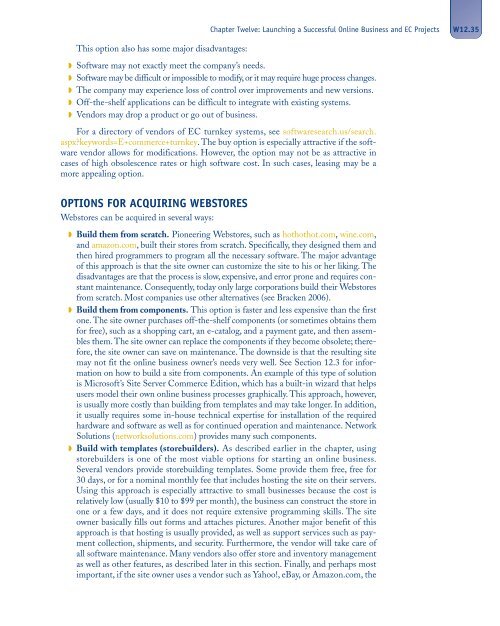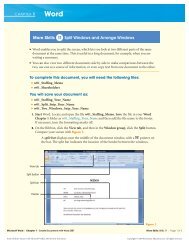launching a successful online business and ec projects - Prentice Hall
launching a successful online business and ec projects - Prentice Hall
launching a successful online business and ec projects - Prentice Hall
Create successful ePaper yourself
Turn your PDF publications into a flip-book with our unique Google optimized e-Paper software.
This option also has some major disadvantages:<br />
Chapter Twelve: Launching a Successful Online Business <strong>and</strong> EC Proj<strong>ec</strong>ts W12.35<br />
◗ Software may not exactly meet the company’s needs.<br />
◗ Software may be difficult or impossible to modify, or it may require huge process changes.<br />
◗ The company may experience loss of control over improvements <strong>and</strong> new versions.<br />
◗ Off-the-shelf applications can be difficult to integrate with existing systems.<br />
◗ Vendors may drop a product or go out of <strong>business</strong>.<br />
For a dir<strong>ec</strong>tory of vendors of EC turnkey systems, see softwaresearch.us/search.<br />
aspx?keywords=E+commerce+turnkey. The buy option is esp<strong>ec</strong>ially attractive if the software<br />
vendor allows for modifications. However, the option may not be as attractive in<br />
cases of high obsolescence rates or high software cost. In such cases, leasing may be a<br />
more appealing option.<br />
OPTIONS FOR ACQUIRING WEBSTORES<br />
Webstores can be acquired in several ways:<br />
◗ Build them from scratch. Pioneering Webstores, such as hothothot.com, wine.com,<br />
<strong>and</strong> amazon.com, built their stores from scratch. Sp<strong>ec</strong>ifically, they designed them <strong>and</strong><br />
then hired programmers to program all the n<strong>ec</strong>essary software. The major advantage<br />
of this approach is that the site owner can customize the site to his or her liking. The<br />
disadvantages are that the process is slow, expensive, <strong>and</strong> error prone <strong>and</strong> requires constant<br />
maintenance. Consequently, today only large corporations build their Webstores<br />
from scratch. Most companies use other alternatives (see Bracken 2006).<br />
◗ Build them from components. This option is faster <strong>and</strong> less expensive than the first<br />
one. The site owner purchases off-the-shelf components (or sometimes obtains them<br />
for free), such as a shopping cart, an e-catalog, <strong>and</strong> a payment gate, <strong>and</strong> then assembles<br />
them. The site owner can replace the components if they b<strong>ec</strong>ome obsolete; therefore,<br />
the site owner can save on maintenance. The downside is that the resulting site<br />
may not fit the <strong>online</strong> <strong>business</strong> owner’s needs very well. See S<strong>ec</strong>tion 12.3 for information<br />
on how to build a site from components. An example of this type of solution<br />
is Microsoft’s Site Server Commerce Edition, which has a built-in wizard that helps<br />
users model their own <strong>online</strong> <strong>business</strong> processes graphically. This approach, however,<br />
is usually more costly than building from templates <strong>and</strong> may take longer. In addition,<br />
it usually requires some in-house t<strong>ec</strong>hnical expertise for installation of the required<br />
hardware <strong>and</strong> software as well as for continued operation <strong>and</strong> maintenance. Network<br />
Solutions (networksolutions.com) provides many such components.<br />
◗ Build with templates (storebuilders). As described earlier in the chapter, using<br />
storebuilders is one of the most viable options for starting an <strong>online</strong> <strong>business</strong>.<br />
Several vendors provide storebuilding templates. Some provide them free, free for<br />
30 days, or for a nominal monthly fee that includes hosting the site on their servers.<br />
Using this approach is esp<strong>ec</strong>ially attractive to small <strong>business</strong>es b<strong>ec</strong>ause the cost is<br />
relatively low (usually $10 to $99 per month), the <strong>business</strong> can construct the store in<br />
one or a few days, <strong>and</strong> it does not require extensive programming skills. The site<br />
owner basically fills out forms <strong>and</strong> attaches pictures. Another major benefit of this<br />
approach is that hosting is usually provided, as well as support services such as payment<br />
coll<strong>ec</strong>tion, shipments, <strong>and</strong> s<strong>ec</strong>urity. Furthermore, the vendor will take care of<br />
all software maintenance. Many vendors also offer store <strong>and</strong> inventory management<br />
as well as other features, as described later in this s<strong>ec</strong>tion. Finally, <strong>and</strong> perhaps most<br />
important, if the site owner uses a vendor such as Yahoo!, eBay, or Amazon.com, the

















